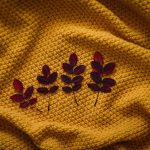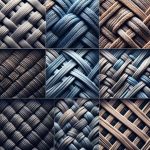Ready to master the art of weaving? Understanding how to read a weaving diagram is crucial for unraveling the intricate patterns and structures of woven textiles. By following a structured approach, you can decode the weaving draft, identify the warp and weft, read the tie-up, analyze pattern repeats, and interpret color and structure with ease.
This detailed guide will walk you through the essential steps, helping you gain a comprehensive understanding of weaving diagrams.
So, let's dive in and unlock the secrets of weaving diagrams together!
Key Takeaways
- Weaving draft depicts the interlacement of warp and weft threads.
- Understanding the draft helps understand the sequence of thread interlacement and the structure of the fabric.
- The tie-up configuration shows the relationship between treadles/harnesses and shafts/frames, which helps interpret treadling and lifting patterns.
- Analyzing pattern repeats helps identify the smallest segment of the pattern, observe variations within the repeat unit, and determine if the pattern exhibits symmetry or asymmetry.
Understanding the Weaving Draft
To understand the weaving draft, study the interlacement of warp and weft threads in the weaving pattern. The warp and weft are the two basic components of any woven fabric.
The warp threads run vertically on the loom, while the weft threads are woven horizontally through the warp. In the weaving draft, the interlacement of these threads is depicted to show how the fabric is constructed. Each square on the draft represents an intersection of warp and weft threads.
By analyzing the draft, you can understand the sequence in which the warp and weft threads interlace to create different patterns and textures. Pay close attention to how the warp and weft threads interact; this will give you insight into the structure of the fabric.
Understanding the interlacement of threads is essential for interpreting weaving patterns and creating your own designs. It forms the foundation for mastering the art of weaving and allows you to manipulate the warp and weft to produce intricate and beautiful fabrics.
Keep practicing and analyzing different weaving drafts to enhance your understanding of thread interlacement.
Identifying Warp and Weft
Identify the warp and weft threads by studying the weaving pattern's interlacement. Understanding the fundamental weaving techniques helps you distinguish between the two essential components of a woven fabric.
- Look for vertical threads: The warp threads run parallel to the selvage edges and are usually the first threads to be put onto the loom.
- Identify horizontal threads: The weft threads run perpendicular to the selvage edges and are woven over and under the warp threads to create the fabric.
- Examine the weave structure: Different weave structures, such as plain weave, twill weave, and satin weave, affect how the warp and weft threads interlace and produce distinct fabric textures.
- Recognize the tension differences: The warp threads are typically under higher tension than the weft threads, providing stability and strength to the fabric.
- Analyze the pattern repeats: By observing how the warp and weft threads interact within a pattern repeat, you can gain insight into the fabric's construction and design.
Mastering the identification of warp and weft threads is crucial for interpreting weaving diagrams and understanding how different weaving techniques create diverse fabric textures and patterns.
Reading the Tie-Up
Examine the tie-up's configuration to understand how your treadles or harnesses are connected to the warp threads for weaving intricate patterns. The tie-up is a crucial element in weaving that determines the interaction between the treadles or harnesses and the warp threads. By analyzing threading, you can interpret how the tie-up creates the lifting pattern for the warp threads, which directly affects the design of your fabric.
When reading the tie-up, start by identifying the tie-up configuration, which shows the relationship between the treadles or harnesses and the shafts or frames. This configuration is usually represented in weaving drafts with tie-up boxes and indicates which harnesses are connected to each treadle or lever. Understanding this connection is essential for interpreting treadling, as it enables you to see how different treadling sequences will lift the warp threads to create various weave structures.
As you analyze the tie-up, pay attention to how the different treadles or harnesses are tied to the individual warp threads. This detailed examination will allow you to grasp the intricate interlacement of warp and weft threads, leading to a deeper understanding of how the tie-up influences the weaving process.
Analyzing Pattern Repeats
As you analyze the tie-up, understanding pattern repeats aids in visualizing the sequence of warp and weft interactions for accurate weaving. Repeating motifs and pattern variations are key elements to consider when analyzing pattern repeats in a weaving diagram. Here are some essential points to keep in mind:
- Identifying the Repeat Unit: Look for the smallest segment of the pattern that repeats across the width and length of the fabric.
- Noting Variation Within the Repeat: Pay attention to any variations or shifts within the repeat unit, as this can add complexity and visual interest to the fabric.
- Understanding How Repeats Interlock: Take note of how the repeat units interlock with one another to create the overall pattern.
- Recognizing Symmetry and Asymmetry: Determine whether the pattern repeat exhibits symmetry or asymmetry, as this can impact the weaving process and the overall appearance of the fabric.
- Anticipating Pattern Interruptions: Be aware of any potential interruptions in the pattern repeat, such as borders or special motifs, and consider how these elements affect the weaving process.
Interpreting Color and Structure
To comprehend the color and structure of a weaving diagram, consider the interplay between hues and the arrangement of threads, building upon your analysis of pattern repeats.
Color interpretation in weaving diagrams is crucial for understanding how different colors correspond to specific threads or actions. When examining the diagram, take note of the color key or legend that indicates which color represents each type of thread. This will help you visualize how the colors are distributed throughout the pattern.
Additionally, pay attention to how the colors interact with each other within the structure of the weave. Understanding the structural analysis involves examining how the threads intersect and interlace to form the fabric. Look for the relationships between the warp and weft threads, as well as any special techniques or variations in the structure.
Frequently Asked Questions
What Are Some Common Mistakes to Avoid When Reading a Weaving Diagram?
When reading a weaving diagram, common mistakes to avoid include misinterpreting symbols and skipping steps. Understanding symbols is crucial for accuracy. Take your time and double-check each step to ensure success.
How Can I Adapt a Weaving Diagram to Fit a Different Loom or Yarn Size?
To adapt a weaving diagram for a different loom or yarn size, start by understanding the pattern's structure. Make loom modifications as needed and carefully choose yarn substitution. Adjust the pattern accordingly for successful weaving.
Are There Any Tips for Troubleshooting Issues With a Weaving Pattern Based on the Diagram?
When troubleshooting weaving patterns, remember to understand symbols and interpret the pattern. Make adjustments as needed for your loom or yarn size. Double-check threading and treadling, and use appropriate tension for smooth weaving.
Can a Weaving Diagram Be Used for More Complex Weaving Techniques, Such as Doubleweave or Overshot?
Yes, a weaving diagram can be used for advanced techniques like doubleweave and overshot. It provides a visual guide for interpreting complex patterns, but may pose challenges in understanding intricate details and interactions between warp and weft.
Are There Any Resources or Tools Available to Help With Interpreting and Working With Weaving Diagrams?
There are various resources and tools available to help with interpreting and working with weaving diagrams. You can find tutorials, online courses, weaving software, and weaving apps that can assist you in understanding and mastering the art of reading weaving diagrams.
- Tetron Fabric for Marine Applications: Durability and Use Cases - June 18, 2025
- Tetron Fabric for Outdoor Furniture: Weather Resistance and Care - June 18, 2025
- Tetron Fabric for Wall Coverings: Style and Application Tips - June 18, 2025




